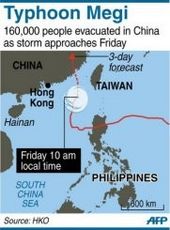
© HKO/AFPTwo dozen missing in Taiwan as typhoon nears China
Typhoon Megi unleashed torrential rains over Taiwan leaving two dozen people missing and hundreds more trapped by landslides Friday, as it bore down on cities along China's southeast coastline.
Megi, the strongest storm to hit the northwest Pacific in two decades, has already killed at least 36 people in the Philippines and was expected to make landfall late Friday or early Saturday in Fujian province in southeast China.
Authorities have evacuated more than 150,000 people from low-lying areas of the province, while 10,000 others have been moved to safer ground in Guangdong. Thousands of fishing boats have been ordered not to put to sea.
"Megi could bring the largest concentration of rainfall this year and will have a serious impact on the province's coast," Fujian's civil affairs department said in a statement.
Projections by the Hong Kong Observatory showed the typhoon was likely hit near the southern Chinese cities of Xiamen and Shantou -- between them home to more than seven million people.
In Taiwan, 20 Chinese tourists and three Taiwanese were unaccounted for after their tourist buses were hit by torrential rains and mudslides, rescuers said.
In hard-hit northeastern Ilan county, flash flooding submerged streets and a railway and forced dozens of schools to shut down.
The island's central weather bureau said more than a metre (three feet) had fallen in Ilan since Thursday.
About 400 people in 32 vehicles were stuck along a mountain road in the county damaged by landslides.
Rescue helicopters had attempted to drop food and other supplies to those trapped, but with no success yet, according to the interior ministry.
"The threat of Megi still exists today and we urge all to be on guard against torrential rains," Taiwan interior minister Jiang Yi-huah said in a statement.
As of 0700 GMT Friday, the storm was located due west of Taiwan's southernmost point, heading towards the population centres along the Chinese coastline.
It was packing maximum sustained winds of around 175 kilometres (110 miles) an hour, but despite its ferocity, it ground only slowly across Asia, moving at less than 10 kilometres an hour, according to Chinese data.
China's State Oceanic Administration issued a yellow storm surge warning, saying waters could exceed the danger levels. Tens of thousands of fishing boats in Fujian and neighbouring Guangdong province were ordered back to port.
The administration and other government agencies have ordered local authorities to reinforce seawalls and protect fishing facilities, the Xinhua news agency said.
China Southern Airlines cancelled flights from the Guangdong provincial capital Guangzhou and Xiamen to the Philippines capital Manila, and said service would be further disrupted to Southeast Asian cities.
Domestic flights originating in Guangzhou were also affected, the
China Daily said, citing airport sources.
Railway ferry services linking the mainland to the southern island of Hainan have been suspended through Saturday, and many coastal cities have also cut ferry services until the storm passes, the newspaper said.
In Hong Kong, some restaurants have offered to re-book wedding banquets, while residents stockpiled canned food, local media reported, even though forecasts suggested the city would escape the full force of the killer storm.
The Hong Kong Observatory however warned of possible flooding in low-lying areas, prompting emergency crews to lay sandbags in preparation.
China was hit earlier this year by its worst floods in more than a decade, with more than 4,300 people dead or missing -- including 1,500 people killed in one devastating mudslide in the northwestern province of Gansu in August.
Megi will be the 13th typhoon to hit China this year.
Reader Comments
to our Newsletter